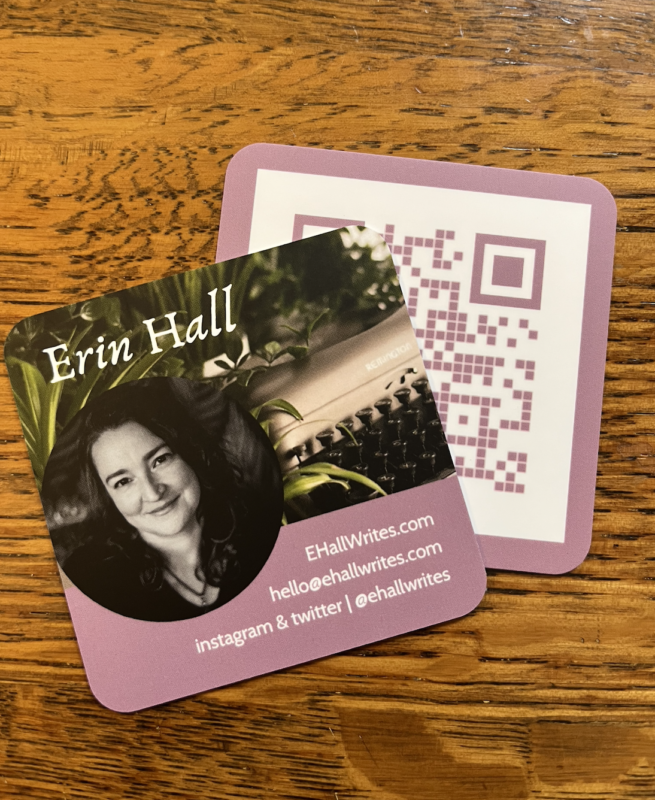As a new member of Willamette Writers, I wanted to create a writer business card for myself in time for this year’s Willamette Writers Conference. While I’ve had business cards in the past for my corporate jobs, this was the first time creating one for my personal brand as a writer.
A business card for a writer is a multifaceted tool. As such, there are multiple factors to decide regarding what should be on your business card and how you want to use it. Here’s how I built my business card.
Why Have a Writer Business Card?
First things first, why should writers have a business card in the first place? The obvious answer is to help you network yourself-as-writer with industry colleagues, writers, publishers, editors, literary agents, book reviewers, and anyone else in the writing and publishing business.
But in addition to making personal connections with new people, your business card can also be used as a key marketing tool for your books. More on that later.

What To Put on Your Writer Business Card
In a former job at a big corporation, I was presented with a big box of hundreds of my new business cards. The first thing I noticed was that our company’s website was nowhere to be seen: a huge oversight! This was even after the design had been looked at and approved by multiple people in the company. So for the sake of covering all our bases, let’s get real clear about what your card should have.
While everyone’s needs are different, the main point of a card is for someone to remember you, be able to contact you privately, and be able to connect with you publiclay on social media (if that’s somewhere you digitally live.)
Writer Business Card Information: The Basics
Your Name
If you use a pen name, it’s up to you if you want to include both your real name and your pen name or just one or the other. If you’re using cards to promote your book, your pen name is sufficient. But if you’re looking to connect with industry professionals, it may be wise to indicate your legal name as well as your pen name.
Preferred Contact Method
Email or phone – whichever you use most often, or feel most comfortable with. Personally I don’t have my phone number on my card because I prefer to communicate via email.
Social Media Platforms
If you use social media for your writer brand (as opposed to simply for personal use), you’ll want to include that on your card. What if you use social media for both personal and business use? Not a problem – include your handles!
But for example, if you only use Facebook to keep up with friends and family, you might not want to be fielding friend requests from someone you met briefly at a conference (then again – you might!). Personally, I have Twitter and my writer-branded Instagram (but not my personal Instagram) on my business card.
Website
If you have a website, you’ll certainly want to include it on your card, even if it’s not something you update with new content regularly.
Writer Business Card Extras

There are a couple of extras I added to my business card that certainly aren’t mandatory, but add a little extra pizzazz (and who doesn’t want more pizzazz?)
Your Photo
The first extra I included is a professional headshot of myself. It’s the same picture I use across my writer-branded social media pages as well as on my website.
The main idea behind this is so that people who find my card in their pocket later have a better chance of remembering me. They don’t have to try to put a face to a name because I’ve already done that for them. If your lizard brain is anything like mine, you may also need to see a face associated with a name repeatedly before you’ll remember someone.
Secondly, since I use the same photo in all my online writerly presence locations, I’m establishing continuity of who I am as a professional writer. Someone who sees me on Twitter, then later Instagram, then later comes across my business card and visits my website, will then have a cohesive visual experience to remember me by.
QR Codes
The second piece of pizzazz I added was a QR code.
A QR code works essentially like a barcode. Every smartphone has the ability to read QR code images using the camera, so it’s a quick and easy way for someone to navigate to a website instead of having to type out on their phone all those https and www and .coms.
Getting a QR code is simple and should always be free. To create one, search online for “QR code generator.” Do your due diligence to make sure the service is legit, but you should never have to pay for a QR code. It’s as easy as inputting the final URL (a website address) you want people to land on, then receiving a downloadable image which you can incorporate in your business card design.
On my business card, the QR code links to the homepage of my website, though they can link anywhere you like (such as a specific page of your website for a specific book, a contact form, your online shop, etc.).
A writer with several published books or online collections could benefit from having separate cards for each project, with a different QR code on each card that directs people to whatever website is the most relevant for that project.
Designing Your Writer Business Card
I used Canva to create a custom design for myself, and then uploaded the designs to Moo to print them.
Both Canva and Moo have template designs you can edit yourself with your information and add any additional images or change fonts to your liking.
Business Card Costs
The cost of your business cards will depend on how many you get, the quality of the paper and ink used by the printer, and possibly how complex and detail-oriented your image is (i.e., if your card is black and white text only vs. full color on both sides).
Another cost factor is how quickly you want the cards shipped to you. Some sites may ship for free, others may charge a few dollars for shipping or have a much higher cost for expedited shipping.
How to Use Your Writer Business Card
Once you have your business cards in hand, what should you do with them? Refer back to our “why” at the beginning of this article for inspiration! But the short answer is to always have some cards handy to pass along to anyone you connect with about writing or publishing.
But here’s a secret about business cards.
The absolute best way to use business cards is to respond to the ones you receive.
That’s right, let’s forget for a second about everything we just learned about making your perfect business card. When I hand someone my business card I don’t have any control over whether or not they ever reach out to me. But if I have their business card I can be sure to reach out to them to establish the connection.
So while we want to make our cards pretty and useful, the most effective way to make business cards work for you is if you take action on cards you receive. Even if it’s dropping a line to say “It was great to meet you at the conference. I’ll start following you on Twitter to see what you’ll be up to in the future!”
That reminds me, I have some business cards I need to respond to.
Erin Hall (she/her) is a writing instructor, small business marketing coach, bookseller, and author of personal essays, short stories, and historical fiction. She lives and writes in Oregon Wine Country. Follow her on instagram @ehallwrites.
